As we continue to trend towards e-commerce and a range of delivery methods for products, warehouses – one of the key infrastructure elements of delivery – are going to both shift and proliferate. A report from Colliers looks at these shifts broadly, but pertinent to this blog, there are sections on First Mile and Last Mile of delivery that outline the changes we will be seeing in the built environment. Some takeaways:
- Large consolidation of distribution facilities is happening as this facilitates logistics and the implementation of automation
- Due to this consolidation, the size of facilities is greatly increasing – ‘First Mile’ facilities (these are distributions centers that are first accepting parcels from suppliers) greater than 1 million square feet are becoming more commonplace. — Picture a single facility as large as 4-5 New York City blocks or 16-20 Portland blocks.
- ‘Last Mile’ facilities (distribution centers that ship directly to customers) – on the other hand are locating in order to shorten and speed up final deliveries. This is leading to smaller distribution centers (50-75,000 square feet) scattered around urban areas.
A great graphic that shows the complexity of new shopping and delivery methods is below. Many forms of delivery and each has its own land use and transportation implications.


